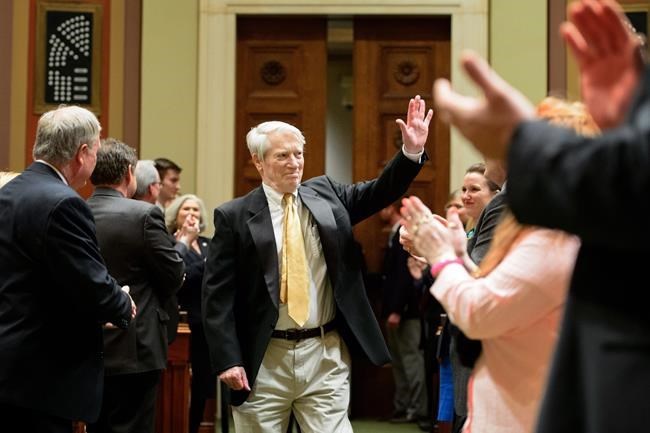
FILE - In this Thursday, April 9, 2015, file photo, former Minnesota Gov. Wendell Anderson arrives in the House Chamber to a rousing applause before present Gov. Mark Dayton delivers his 2015 State of the State address in the House Chamber of the Minnesota State Capitol, in St. Paul, Minn. Anderson, a former U.S. Olympian who was described in a 1973 Time magazine cover article as the youthful embodiment of his home state only to lose public confidence later by arranging his own appointment to the U.S. Senate, died Sunday, July 17, 2016. He was 83. (Glen Stubbe/Star Tribune via AP)
Republished July 17, 2016 - 11:33 AM
Original Publication Date July 17, 2016 - 9:55 AM
ST. PAUL, Minn. - Wendell Anderson loved being Minnesota's governor so much that he couldn't wait to get to work in the morning. But when he abandoned the Capitol in a slippery move to get to Washington, voters never forgave the youthful Democrat who just three years earlier won statewide accolades for embodying Minnesota's strengths on an iconic Time magazine cover.
Anderson, a handsome Olympic silver medallist in hockey, gave up the job he loved in 1976, resigning so that second-in-command Rudy Perpich could become governor and name him to fill the U.S. Senate seat vacated by newly elected Vice-President Walter Mondale. The move was deeply unpopular and voters decisively ousted Anderson two years later in favour of Republican Rudy Boschwitz.
Anderson, who died Sunday at 83, was never elected again, though friends said he longed to return to public life.
Gov. Mark Dayton's office said Anderson died at Our Lady of Peace hospice care in St. Paul.
Anderson's family issued a statement, calling the former governor many things: "A kid from East St. Paul. A Gopher. An Olympian. An elected public servant of the highest order. But above all else he was a Minnesotan. His love for the state and its citizens was second only to his love for his family."
Anderson reached the summit of Minnesota politics in 1970 when he won the governor's office at age 37.
The next year, he pushed through an overhaul of school aid and taxes that became known as the "Minnesota miracle." In a special legislative session that stretched more than five months past normal deadlines, Anderson outmanoeuvred the conservative-dominated Legislature by rejecting an alternate tax plan he called "the old way of doing things." The victory gave him latitude to pursue Democratic priorities such as environmental safeguards, a minimum wage increase and programs for housing, seniors and drug abuse.
The outdoorsy governor familiarly known as "Wendy" landed on the cover of the Aug. 13, 1973 issue of Time, shown hoisting a trophy fish over the headline "The Good Life in Minnesota." The story inside called Anderson a "Midwestern Kennedy."
Anderson brought a star quality to the state's top job, with his good-looking blond wife, Mary, and three young children, Amy, Elizabeth and Brett. He appeared in newspaper photographs jogging, hitting a baseball and tromping around in a parka with a fur collar. One Minneapolis Star columnist said he was so good on television that "it's possible people don't even hear what he's saying." Way back in 1971, press reports said he had a car phone that used radio frequencies for a range of 30 miles from downtown Minneapolis.
The son of a sausage delivery truck driver, Anderson was born on Feb. 1, 1933, in St. Paul, where he grew up on the city's blue-collar East Side. He played hockey at Johnson High School and the University of Minnesota, where he got his law degree while serving in the Legislature. He was an Army infantry officer and won a silver medal as a member of the U.S. hockey team in the 1956 Olympics.
He jumped into politics young, winning his first election to the Minnesota House in 1958 when he was just 25 and moving up to the state Senate four years later. He headed Vice-President Hubert H. Humphrey's Minnesota presidential campaign in 1968 before running for governor in 1970.
Anderson crushed his Republican opponent, John Johnson, by a better than 2-to-1 margin to win a second term in 1974. Talk soon began about a future in national politics. Anderson joined the Democratic National Committee's executive committee and became chairman of the party's platform committee.
Anderson's fall began when he resigned as governor on Dec. 26, 1976, to claim Mondale's Senate seat.
Anderson announced plans to run for the seat in 1978, adding, "I don't fear submitting my name to the vote of the people."
But the self-appointment was unpopular from the beginning. He apologized in a TV ad, saying, "Many tell me it was a mistake, and I accept your judgment." Voters rejected Anderson by a wide margin in 1978, electing Boschwitz instead.
"It didn't help that he so-called 'appointed himself,'" Boschwitz told The Associated Press on Sunday. "It didn't help him, but it could be that the year was just such it wouldn't have made any difference."
Friends said Anderson longed to return to the political life, but it wasn't to be. He sought the Democratic-Farmer-Labor Party's endorsement for a rematch with Boschwitz in 1984, but dropped out after finishing last in a field of four. He served on the University of Minnesota Board of Regents, practiced law and pursued business ventures. He also served as Sweden's honorary consul to Minnesota. Anderson and his wife, Mary, divorced, and by the early 1990s, his debts made the newspapers. He modeled exercise equipment and a sweatshirt.
But his friend, former Democratic Senate Majority Leader Roger Moe, has said Anderson should be remembered for what he accomplished.
"His tenure as governor will go down in the history books as probably the six most productive years in terms of progressive, forward-looking state government," Moe said.
Memorial services are pending, Dayton's office said.
News from © The Associated Press, 2016